Excerpts from Jim Conrad's
Naturalist Newsletter
from the December 5, 2004 Newsletter, issued from Komchen Reserve near Dzemul, Yucatán, MÉXICO
BLACK IGUANAS
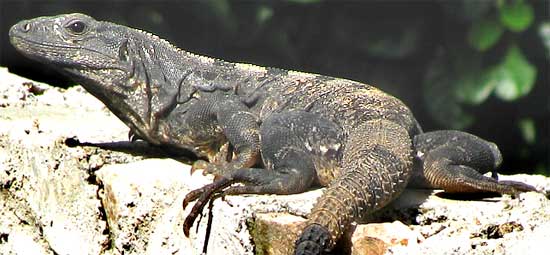
That's a Black Iguana, CTENOSAURA SIMILIS, above. In other places where I've lived with iguanas I never paid much attention to them because basically they just lay around in the sun digesting the miscellaneous stuff they'd eaten. This week they've been on my mind, however, because I've cleaned out the henhouse and begun trying to get our chickens civilized enough to provide us with a few eggs. The problem is that Black Iguanas eat both eggs and chicks. We'll just see how things work out between the iguanas, chickens and me.
We have three dogs here and they just love going after iguanas. A dog may scrape and scratch for half an hour at a crevice or hole where his nose tells him there's an iguana, but I've never seen a dog actually touch one.
What's funny is to see a dog with an iguana safely holed up someplace with just a bit of his tail showing. The thing is, that six inches of iguana tail could as well belong to a foot-long juvenile iguana as to a three-foot long, chicken-eating one. You'd be surprised how philosophical a dog's face becomes as the implications of that reality sink in.
NOTE ADDED LATER: Later I saw dogs in other places attack and kill small to medium-size Black Iguanas. Also, Black Iguanas ate all my vegetable garden sowings as soon as the plants were an inch or so high.
from the November 22, 2009 Newsletter, issued from Hacienda Chichen Resort beside Chichén Itzá Ruins, central Yucatán, MÉXICO; limestone bedrock, elevation ~39m (~128ft), ~N20.676°, ~W88.569°
BLACK IGUANA UP CLOSE
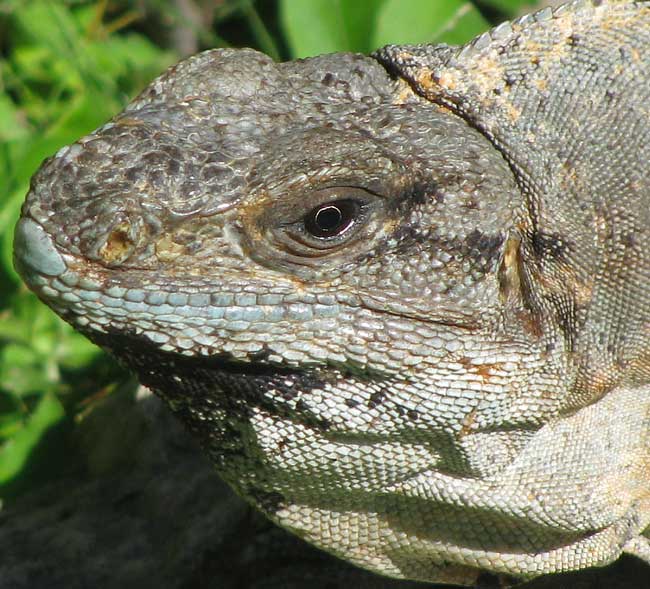
At other places I've visited the Black Iguanas, CTENOSAURA SIMILIS, have been much more wary of being approached than those here. That's probably because here we don't have people and dogs likely to eat them. The other day a two-foot one perching on a rock let me get within six feet, making possible the portrait above.
Having such a detailed picture, it's interesting to look at some special iguana features. For example, in the picture follow the black line extending back from the eye and you'll come to a brownish, wedge-shaped depression, which is an ear. The various folds beneath the eye reflect the fact that, in contrast to snakes, most lizard types have eyelids. Many lizards have a well-developed pineal or "third" eye in the middle of the back of the head containing a transparent, light- sensitive disk thought to regulate hormones serving the animal's biological clock. I'm wondering if that sunken area behind the eyes and before the flap across the back holds this iguana's pineal eye?
Small, green iguanas are everyplace here but they're not Green Iguanas, Iguana iguana. You can see one below:
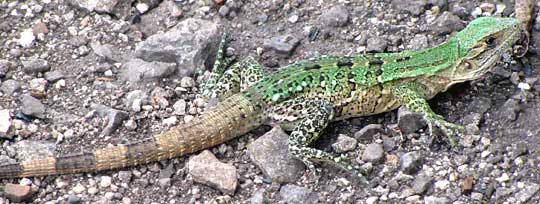
Both Green and Black Iguanas occur throughout southern Mexico and the adults are easy to distinguish from one another. However, young Green and young Black Iguanas can easily be confused since both are green and both bear broad, vertical, black bands. Green Iguanas spend nearly their entire lives in trees, however, and are seldom seen far from water, while these are ground- lovers and range far from water sources.
from the October 26, 2014 Newsletter issued from Río Lagartos, on the Yucatan Peninsula's northern coast (~N21.60°, ~W88.16°), Yucatán state, MÉXICO
A YOUNG, WHITISH, BLACK IGUANA
Atop the low concrete storm wall separating one of Río Lagartos's backstreets from a mangrove swamp a lizard about a foot long was basking in the sun, as shown below:
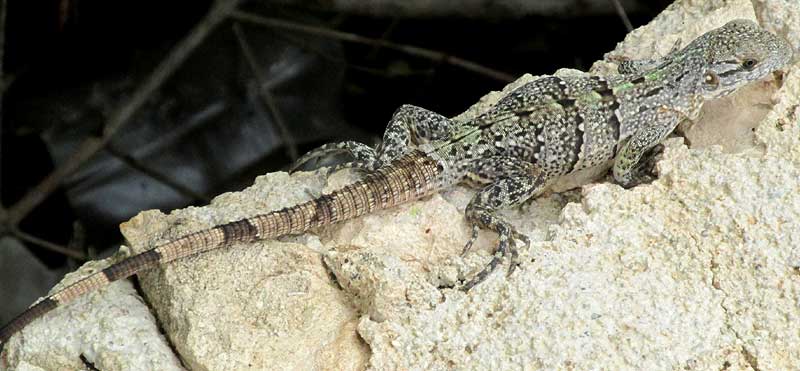
A close-up of the head is at shown below:
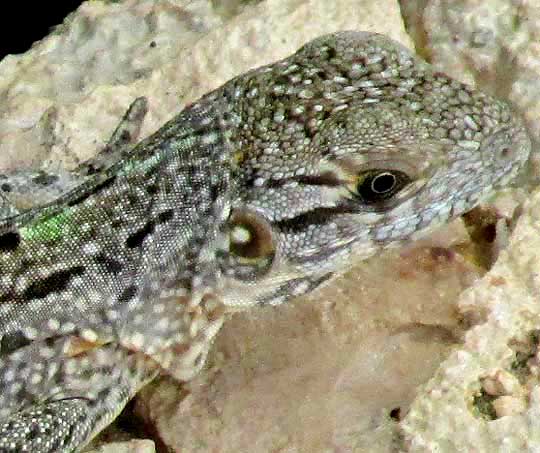
And a shot showing the whitish underside is shown below:
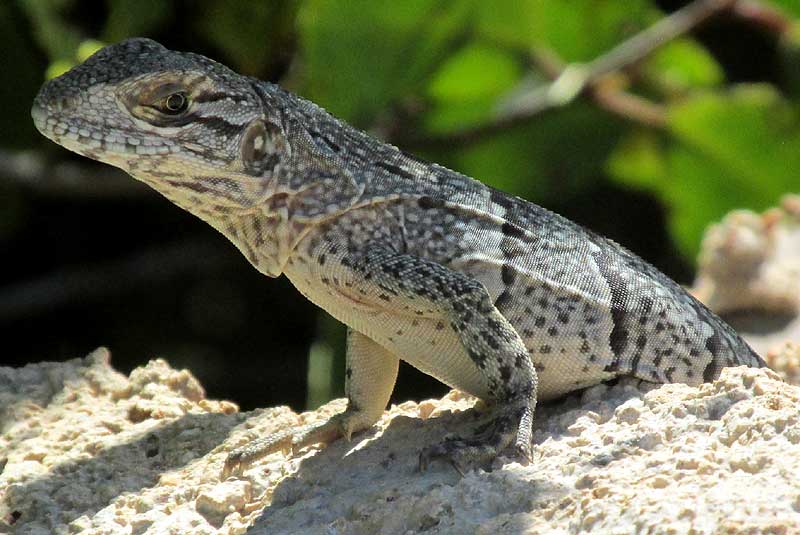
The pale coloration and bold crossbanding didn't match any of the lizard pictures in Jonathan Campbell's Amphibians and Reptiles of Northern Guatemala, the Yucatán and Belize, but it most resembled what that book labeled Bourgeau's Anole, Norops bourgeaei. Since the book's publication the names have changed to White Anole, Anolis laeviventris.
However, something bothered me about this determination. First, there's a hint of green along our lizard's spine, not mentioned in descriptions of Anolis laeviventris. Also, our picture showing the lizard's chest reveals a definite fold extending across the chest from above each front leg. Anoles have skin flaps there that fan out longitudinally -- lengthwise -- not crosswise.
The short story is that I had to go on the Internet and confer with an anole expert, Jonathan Losos at Harvard, to be hit with the embarrassing but obvious truth that our lizard isn't an anole at all, but rather our abundant Black Iguana, which habitually perches atop rock walls just as ours is doing. How could this lizard have fooled me so?
Well, I just hadn't seen this particular stage of development in our Black Iguana, other immature Black Iguanas I've seen this size were green, and I guess I'm getting slow. When Black Iguanas are very young, they're green. As they mature they not only develop low spines, especially the males, but also become whitish, then begin growing darker.
So, there you go. Don't depend too much on pictures in one field guide, and don't get stuck on wrong first impressions.
from the November 1, 2005 Newsletter, issued from Hacienda San Juan near Telchac Pueblo, Yucatán, MÉXICO
IGUANAS EAT BANANA PEELINGS, DOGS EAT IGUANAS
Possibly we have even more Black Iguanas, CTENOSAURA SIMILIS, here than at my location last year, though the ones here tend to be smaller.
I eat a lot of bananas and the iguanas eat my peelings. I place the peelings atop a stone wall in the sunlight and it's seldom long until an iguana appears. At first meeting the iguana flicks the peeling with his red tongue, waits a few seconds, then takes a bite and waits a while longer, and finally takes several more bites. Typically the lizard gets part of the peeling into his mouth, then vigorously swings his head back and forth just like a chicken with something too big to swallow. With both chickens and iguanas, sometimes the shaken thing breaks, with a piece of manageable size remaining in the mouth. Also as with chickens, the greater part of the shaken thing gets slung beyond reach. The iguanas knock far more peelings off the wall than they eat.
It's not surprising that iguanas would sling their heads like chickens. In biological terms, there's not much difference between reptiles and birds. Birds are almost nothing more than the feathered evolutionary remains of little dinosaurs.
When a chicken poops, the white paste on the poop is mostly uric acid -- urine with the water removed for recycling in the bird's body. The other day I saw an iguana relieve himself and there was no white paste to it. What came out could have been fox poop, and plenty of liquid streamed over the rocks below.
Last year at Komchen the dogs chased iguanas but I never saw an iguana get caught. Here iguanas regularly get caught and eaten. One dog, a German Shepherd, spends many afternoons barking interminably at a pile of rocks with an iguana inside it. Another, a little brown bitch with one drooping ear and big black teats, eyes an iguana-chasing situation and either attacks instantly or walks on, and if she attacks she often gets her iguana without a bark.
Different philosophies of life...
from the February 27, 2011 Newsletter issued from Hacienda Chichen Resort beside Chichén Itzá Ruins, central Yucatán, MÉXICO; limestone bedrock, elevation ~39m (~128ft), ~N20.676°, ~W88.569°
AN IGUANA EATS MY YELLOW COSMOSES
One morning half my bed of French Marigolds turned up missing. At first I blamed rabbits because most plants had been severed halfway up their stems, and I've see rabbits eat like that. Birds tend to pull up the whole little plant, then leave much or most of it on the ground. But my friend José pointed out that around here you hardly ever see a rabbit. It was much more likely that my flowers had been eaten by iguanas, which forage both during the day and night.
I salvaged what plants I could and transplanted ones from where they'd grown too close together to where nothing remained, and hoped that sprouts might emerge from the stumps. An then as I rested from that work, sitting in front of the hut, in broad, late-morning daylight, here came lumbering across my open area a 2½-ft-long (75cm) male iguana, showing no concern at all about entering my living space. He slid his big belly and spiny-topped tail over the marigold bed I'd just replanted, gobbled down most of a weedy amaranth, and as my camera was grinding to life he traversed a bed of young purslane, pushed his front end over a jagged rock used as a bed-border, and took into his mouth one of my Yellow Cosmoses, as seen below:
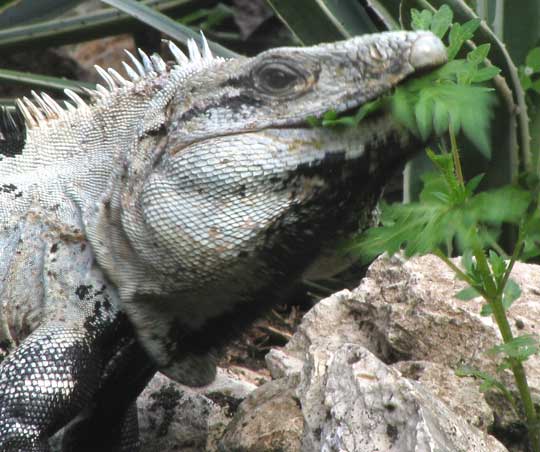
Picture taken, I ran at him shaking my walking stick, thumping the ground with it. The brute just looked at me as if I had no right to distract him from his meal. A good prod in the side, though, and off he went, half-heartedly, the injustice of it all clearly expressed in his glaring eyes and body language.
Since that encounter each day the big fellow saunters past the hut, taking his time, and really I don't think he's particularly interested in my flowers. He just gets walking in a certain direction and eats a little of whatever he blunders into, and for awhile there he was blundering into my flowers.
from the February 27, 2011 Newsletter issued from Hacienda Chichen Resort beside Chichén Itzá Ruins, central Yucatán, MÉXICO; limestone bedrock, elevation ~39m (~128ft), ~N20.676°, ~W88.569°
IGUANA DIGESTION
Actually, the matter of iguana digestion has its interesting points. A surprising amount of information is available, maybe because so many people keep big iguanas as pets, and in some developing countries they're looking at farming larger iguana species for food.
We tend to think that digestion in human guts is neatly handled by gastric juices, which antiseptically melt what we eat into useful chemical compounds. We ignore the fact that human guts host more than 400,000,000,000,000 microbes of at least 400 types, which means that our guts amount to seething, bubbly stews of microbial action. It's even much more so with big, plant-eating iguanas such as our Black Iguanas.
In fact, three main conditions are necessary for our big iguanas to digest their food properly: The presence of elevated heat (attainable while basking in sunshine); gut microbes that break down what's eaten, and; the process of fermentation, which does magical things to otherwise indigestible food.
Remembering that to a certain point heat tends to speed up chemical processes, and that our own guts are microbe heavens, the importance of elevated heat and gut microbes doesn't surprise us. However, I hadn't realized that the process of fermentation is so important.
In the context of food processing, fermentation is regarded as the conversion of carbohydrates such as cellulose, sugars and starch to alcohols and carbon dioxide or organic acids. Yeasts and/or bacteria accomplish the conversion. Maybe the most distinctive feature of fermentation is that by definition it's accomplished without oxygen. It's an anaerobic process.
When I watched my Yellow Cosmos disappear into the maw of the big iguana, most of the plant's non-water content was carbohydrate, and the same was true of all the other herbs the big lizard had eaten that day. In the oxygen-poor environment of the iguana's gut, fermentation is what turned the cosmos's indigestible cellulose, fiber, etc. into simpler compounds easier for the iguana's body to absorb and work with.
from the February 27, 2011 Newsletter issued from Hacienda Chichen Resort beside Chichén Itzá Ruins, central Yucatán, MÉXICO; limestone bedrock, elevation ~39m (~128ft), ~N20.676°, ~W88.569°
FIGHTING IGUANAS
Visitors often photograph the Hacienda's Black Iguanas basking atop stone walls, in trees and lumbering across the ground. The other day I came upon two in the parking lot clinched together fighting, shown below:
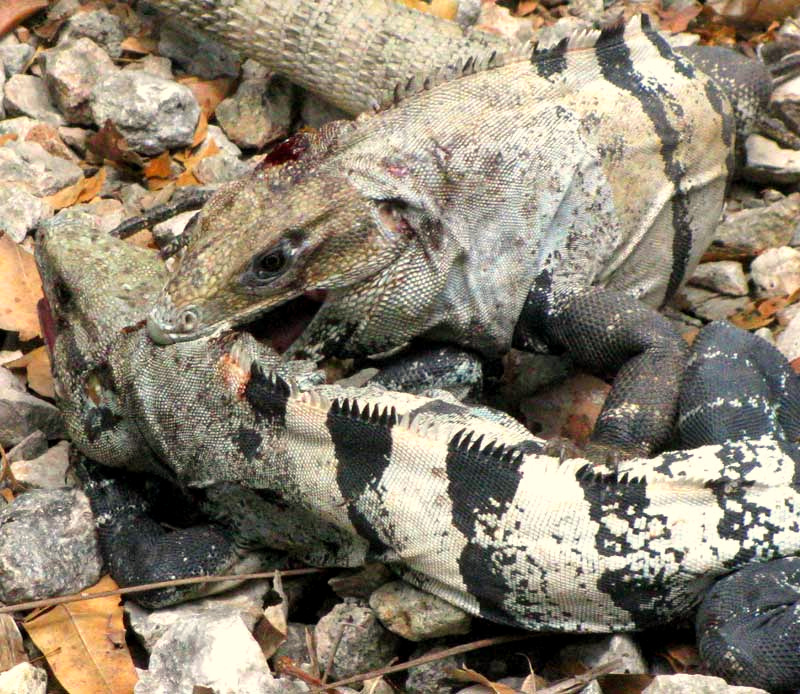
They were young ones, only about 2-½ feet long (75cm), but clearly old enough to fight. Note that both bear bloody spots on their backs behind their heads. When male iguanas do battle the main tactic seems to be to clamp down on the other's nape.
from the March 18, 2006 Newsletter, issued from Hacienda San Juan near Telchac Pueblo, Yucatán, MÉXICO
TWO MALE BLACK IGUANAS BATTLE IT OUT
The instant I arrived at my favorite iguana-watching spot I knew I was in for a show. Atop two stone pillars inside the rubble zone of the old hurricane- collapsed henequen mill, not three feet apart, two yard-long male Black Iguanas, CTENOSAURA SIMILIS, perched glaring and head-lifting at one another. A head-lift consists of throwing the head so far back that the chin points skyward. Lasting for just a second or two it displays the throat, often black- speckled on a gray background, and two big throat pouches that make hormone-juiced-up males look like they have really bad cases of mumps.
One iguana was especially skinny so I named him Wiry, and the other was full-bodied but with a bloody red spot on his back so I called him Bloody. I figured that Wiry was the dominant male in the area and Bloody was a challenger. I've seen that dominant males spend so much time guarding their harem and fighting male interlopers that they don't eat enough and loose weight, so I figured that that was Wiry's story, and maybe Bloody's bloody spot resulted from losing an earlier fight.
After a few minutes Wiry couldn't stand it any longer, descended his pillar and clambered up Bloody's, and the battle began.
Each iguana went for the other's side just behind a front leg. Each seemed about to clamp down on a large section of the other's ribcage but, amazingly, neither bit. Both could have closed their jaws on the other but both held their mouths so wide open that the tips of their teeth hardly touched the other's skin. Instead, they kept maneuvering for better potential bites -- which meant that the pair slowly circled atop the pillar, like strategizing Sumo wrestlers angling for the right moment to strike. When the terrible bites did come they happened so fast that my mind didn't register anything other than that suddenly both had big mouthfuls of the other. Soon it became clear that the goal wasn't to bite into the other's side, but rather to grab the ridge of the back right behind the front shoulders -- where Bloody's bloody spot was.
They held onto one another for three or four minutes but then they came undone, and started it all over again. At the end of the next biting Bloody fell from atop the pillar, ignominiously right onto a lolling female. Wiry slowly descended, both head-lifted at one another like bowing Sumos, and another round ensued.
Three more circlings ending in bitings took place, Bloody getting the worst of it each time. Sometimes Wiry held Bloody with his belly skyward, his legs pawing at the air. Sometimes Wiry, clamped onto Bloody's nape, shook Bloody like a dog shaking a gopher to break its neck. During the last round Wiry could only get Bloody's leg in his mouth but that leg was shaken so violently that I'm sure I saw a large tear open behind Bloody's leg.
After about half an hour, with both iguanas smeared with blood -- mostly Bloody's blood -- Bloody staggered from the arena. He left defiantly head- lifting, but he staggered as he crawled away doing it, and as he pulled himself beneath a rock his defeat looked complete, and it was terrible to behold.
Wiry mounted his front end atop a rock and began a series of head-lifts so extravagantly triumphant that his chin passed the vertical mark, curving his body into a shallow C. Then I noticed the females.
From my perspective I could see eleven females around him and there must have been more. They were positioned so that Wiry could see their entire body lengths. It seemed to me that each female was posing in a way that conveyed this message, "Wiry, I have witnessed your triumph, and I confirm your supremacy." It was like a moment in a Wagnerian opera when lesser gods emerge from the mists eerily chanting glorifications to the higher god.
At the periphery of Wiry's circle of females also I saw four or five somewhat smaller males. They were all signaling with defiant head-lifts, and they were all staring exactly at Wiry.
Clearly, the opera had just begun.
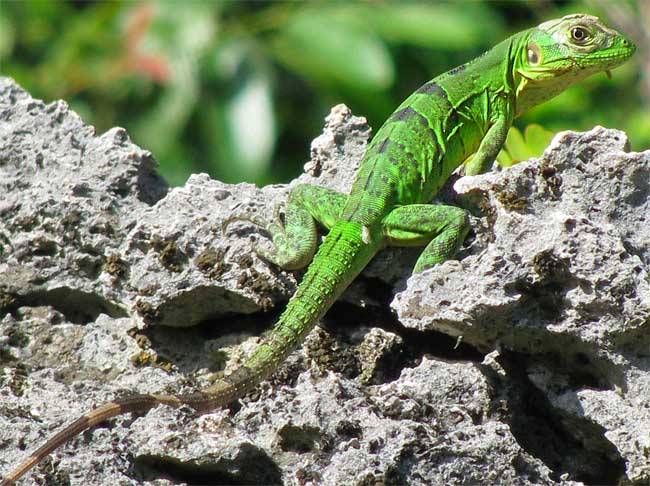
special note about a picture in the August 18, 2008 Newsletter, written in Sabacché and issued from a ciber in nearby Tecoh, Yucatán, MÉXICO
A CENOTE'S GREEN-COLORED IGUANA
Above that's a young green Black Iguana, CTENOSAURA SIMILIS, the top of his head flaky with old, silvery skin being shed. This individual is about 15 inches long.
At first I thought he was a Green Iguana, Iguana iguana, but eventually the true identity dawned on me. It's easy to confuse immature Black and Green Iguanas, though, and both species occur here. Both are green and both bear black bands on the body and tail.
First, Green Iguanas are mainly arboreal and seldom found far from water, while I was seeing these green juveniles on the ground and often far from water.
Second, the fold of skin hanging beneath the Green Iguana's throat runs lengthwise while the Black Iguana's runs across the body. On this juvenile you can see the fold starting to form and it's running across the body -- it's a "transverse fold" as opposed to the Green's "longitudinal fold.
from the August 1, 2010 Newsletter issued from Hacienda Chichen Resort beside Chichén Itzá Ruins, central Yucatán, MÉXICO; limestone bedrock, elevation ~39m (~128ft), ~N20.676°, ~W88.569°
A REALLY GREEN BLACK IGUANA
Running around my hut these days there are immature Blacks as green as what's shown below.
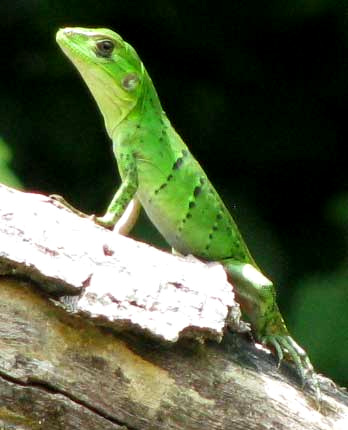
That individual is only about six inches long (15 cm) and I'm not sure I could distinguish it from a young Green Iguana. The main reason I'm sure it's a Black is that so far I've seen no Green Iguanas here, nor would I expect to where there's so little permanent water, which Green Iguanas require.
from the April 4, 2010 Newsletter issued from Hacienda Chichen Resort beside Chichén Itzá Ruins, central Yucatán, MÉXICO; limestone bedrock, elevation ~39m (~128ft), ~N20.676°, ~W88.569°
COPULATING BLACK IGUANAS
Sitting in my room typing I looked up to rest my eyes and there exactly before my open door not 15 feet away lay two unmoving, copulating, 2.5-ft-long (75 cm) Black Iguanas.
Now, Black Iguanas bear sharply spiny fins down their tops and of course they have long, meaty tails, so, once you start thinking about it, you might wonder how they fit themselves together. You can see how below:
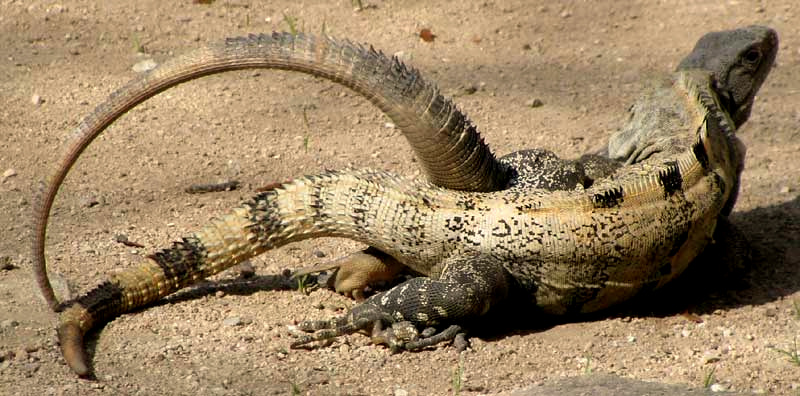
The male assumes such an awkward position that it's not clear how the hidden parts relate. Not seen is the male iguana's secret weapon -- a weapon male lizards share with male snakes -- and that's something referred to as "the paired hemipenis." The paired hemipenis is a somewhat stubby, Y-shaped penis, with both arms of the Y being useful, so things work no matter which side of the female the male mounts.
Different from many species, the males of Black Iguanas tend to be larger than the females. Also -- something showing in the photo if you study it -- the heads of males are broader and have a more massive jaw musculature.
I have no idea how long the couple in the picture had been at it, but I can tell you that instantly after snapping the above picture, before my camera had stored its image and was able to shoot again, suddenly there came a stampeding sound, the copulators broke apart, the female rushed into a hole beneath my door, the male raised a cloud of dust shooting across the volleyball court, and a second male much, much larger (but slower) than the first stormed onto the scene. Finding no satisfaction there he rushed to the center of the court, did some head-lifting displays, and remained there glaring all around for several minutes.
The other two were nowhere to be seen for the rest of the day.
You can see the hemipenis of a European Legless Lizard at https://www.biolib.cz/en/image/id4563/.
from the June 12, 2016 Newsletter issued from Hacienda Chichen Resort beside Chichén Itzá Ruins, central Yucatán MÉXICO
BLACK IGUANA EATING SPANISH PLUMS
Most mid-afternoons as I'm working at the computer, at one point or another a motion catches my attention through the openings of the pole wall beside me, I glance outside, and see something like what's shown below:
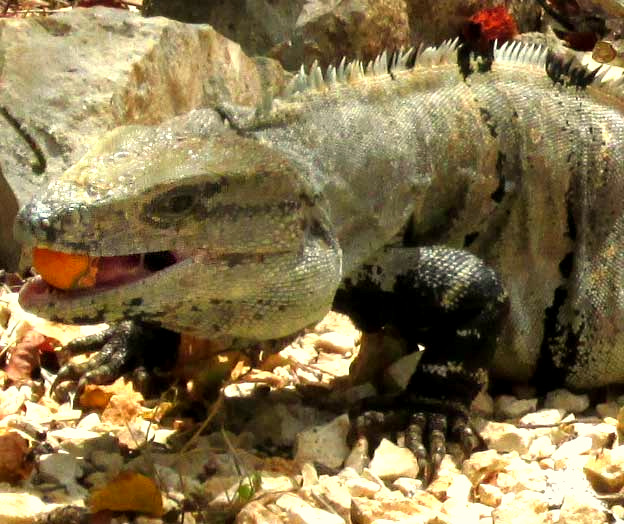
That's a Black Iguana feeding on a ripe Spanish Plum fallen from the tree behind the hut. Our Spanish Plum Page is at www.backyardnature.net/mexnat/spondias.htm
One thing worth noting is that those Spanish Plum fruits consist mostly of a large seed surrounded by just a little flesh. Somewhere our hut iguana must be leaving piles of poop substantially composed of Spanish Plum stone-type seeds.
One reason the above picture is worth posting is because it documents a known species feeding on another known species, and such specific documentation often is hard to come by. Their Wikipedia page says that Black Iguanas are "... primarily herbivorous, eating flowers, leaves, stems, and fruit, but they will opportunistically eat smaller animals, eggs, and arthropods."
Now we are closer to answering which fruits Black Iguanas eat, as well as which dispersal agents help the Spanish Plum disseminate their seeds.
from the August 29, 2010 Newsletter issued from Hacienda Chichen Resort beside Chichén Itzá Ruins, central Yucatán, MÉXICO; limestone bedrock, elevation ~39m (~128ft), ~N20.676°, ~W88.569°
IGUANA IN THE MARIGOLDS
Next to the chair beside the hut's door where I eat breakfast a dense thicket of marigolds about four feet high is just beginning to issue flower buds. In about a month they'll be a pretty sight. As I sit next to them their sharp, medicinal odor suffuses the morning's calm, moist air.
Most mornings, within arm's length of where I'm sitting, an immature Black Iguana perches motionless, either waiting for prey, watching me, or both. He's below:
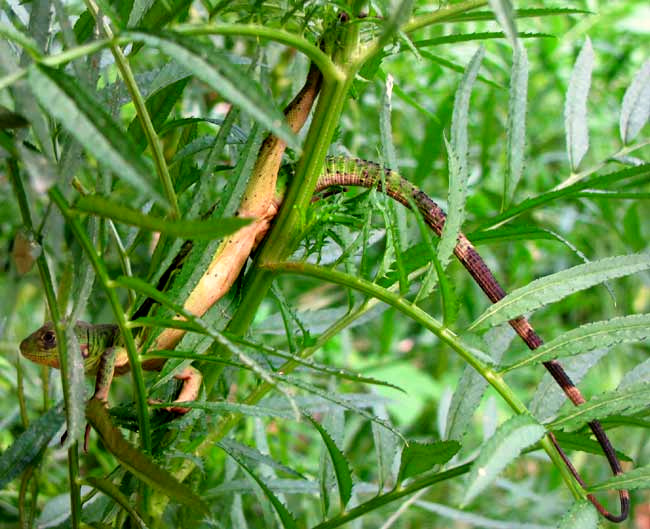
This particular iguana, about a foot long, has almost become a pet. On afternoons when sometimes I read in the door chair he rushes from the general area of the marigolds and perches atop a rock about six feet away. If I get up, he doesn't move. In fact, I can walk right up to him. He's like a dog, but not enough for me to tickle him.
Of course, iguanas have reptilian brains, not mammalian ones, so, theoretically, affection and maybe curiosity shouldn't be part of this critter's behavioral repertory. But, who really knows what's going on in that lizard's brain?
from the July 17, 2016 Newsletter issued from Hacienda Chichen Resort beside Chichén Itzá Ruins, central Yucatán, MÉXICO; limestone bedrock, elevation ~39m (~128ft), ~N20.676°, ~W88.569°
A BLUE-BANDED BLACK IGUANA?
The other day an immature Black Iguana about 30 inches long (80cm) turned up with most of the body orange-tinged, with a pale blue band on the tail and a mask of the same color, shown below:
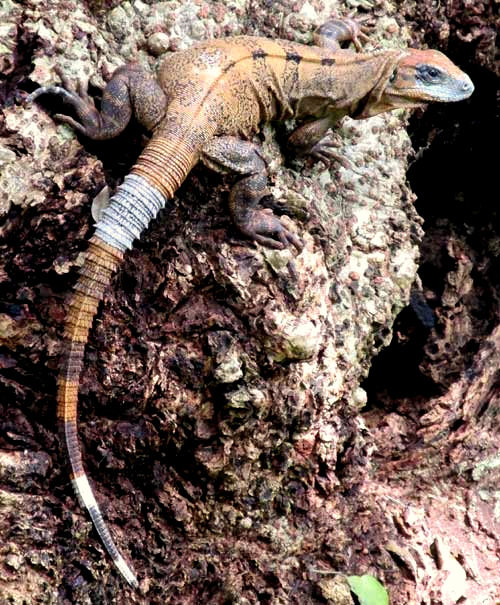
I've been told that sometimes during the breeding season they may acquire an orange tint but those pale blue markings are something I've never heard of. A tour guide who frequently comes with busloads of German visitors insists that someone is painting our iguanas. I just don't know. If they are painting them, they're doing a neat job.
Does anyone out there have experience with such multi-hued iguanas?